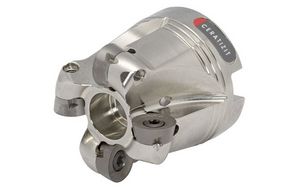Because of their exceptional mechanical properties, titanium and titanium alloys are used for application under extreme loading conditions as they occur for example in aerospace technology. However, the beneficial characteristics of these metals with respect to their application puts extremely high demands on the cutting tools that are used in the manufacturing processes of titanium parts. Besides the chemical attack to the tools’ cutting edges, they are subjected to a detrimental combination of high temperature and high cutting forces. Nonetheless, there is an ever-increasing trend to increase the cutting parameters and hence the tool loading rather than to protect the tools during manufacturing. The overall aim is to increase the efficiency of the metal cutting process. Tools made of WC-Co hard metals have proven to cope with this industrial practice. Hard metals consist of a hard phase embedded in a ductile binder phase as for example tungsten carbide and cobalt. Tool development with the aim to increase the durability and the cutting parameters requires a sound knowledge of the actual tool loading and the associated damage-relevant processes on the microstructural level. In cooperation with Ceratizit Austria, a premium supplier in the field of cutting tools, researchers at the MCL investigated the cutting process and tool materials via a combination of experimental and numerical methods to establish the essential fundamentals for further tool development. Until recently, the tool loading had been known in terms of the cutting forces and the background temperature of the cutting tool only. However, this is rather insufficient information because the maxima of the thermal and mechanical loads are concentrated at the leading cutting edge that is in contact with the machined material. A novel finite-element-based simulation approach developed at the MCL, now enables the analysis of the tool loading in the
immediate vicinity of the cutting edge. The simulations provide the spatial distribution as well as the cyclic evolution of the temperature, stresses and strains during multiple subsequent cutting operations. The now available detailed information on the thermomechanical tool load situation facilitates the design of laboratory experiments with the tool material under these conditions. In order to analyze the creep and fatigue behavior of different hard metal grades under the conditions identified to be relevant to the tool’s cutting edge, the samples are heated up to 800°C under vacuum and subjected to static as well as cyclic loads. In order to understand the relevant damage mechanisms and the limit loads for the save application of hard metal tools, the early stages of material damage under the extreme loads were investigated by means of detailed microstructural analysis. The high practical relevance of the combined computational and experimental approach was proven by comparison with the microstructure of cutting inserts that have been operated in real cutting experiments. Ultimately, the combined approach enables to investigate and analyze different hard metal grades and tools under conditions that mimic the real-world process and hence facilitates tool development.
Impact and effects
The results are an essential contribution to safeguard the technological leadership in the field of the development and production of high-performance cutting tools. Efficient cutting tools and processes are a prerequisite for the domestic industry including tool manufacturer as well as part makers to succeed in the competitive worldwide market.
Project coordination
Dr. Thomas Klünsner
Project coordinator
Materials Center Leoben Forschung GmbH
T +43 (0) 3842 45922 33
thomas.kluensner(at)mcl.at



















